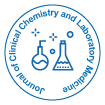
Journal of Clinical Chemistry and Laboratory Medicine
Open Access
ISSN: 2736-6588

ISSN: 2736-6588
Short Communication - (2021)Volume 4, Issue 9
A Nucleic Acid Test (NAT) is a procedure used to recognize a specific nucleic acid succession and to distinguish and distinguish a specific animal groups or subspecies of an organism, frequently an infection is caused due to presence of microorganism in blood, tissue, and so on NATs contrast from different tests in that they identify hereditary (genetic) materials (RNA or DNA) rather than antigens or antibodies. Identification of genetic materials permits an early conclusion of disease of the fact that the location of antigens as well as antibodies requires time for them to begin to appear in the circulation stream. Since the measure of a specific genetic material is generally small, numerous NATs incorporate a stage that intensifies the genetic material which makes many duplicates of it; which are called as Nucleic Acid Amplification Tests (NAATs). There are multiple methods of intensification, including Transcription Mediated Assay (TMA), Polymerase Chain Reaction (PCR), and Strand Displacement Assay (SDA). All NAATs and discovery advancements utilize the particularity of Watson-Crick base pairing; single-stranded test to capture DNA or RNA targets of corresponding strands. Subsequently, the plan of test strands is exceptionally important to raise the specificity and sensitivity of the discovery. However, the mutants which structure the hereditary basis for an assortment of human disease are generally unique in relation to the typical nucleic acids. Frequently, they are just divergent in a single base, ex: additions, deletions, and Single-Nucleotide Polymorphisms (SNPs). In this case, improper test target restriction can occur as false results, for example, mistaking a strain that is commensal with one that is pathogenic. Future researches have been devoted to accomplishing single-base specificity [1].
Nucleic acid (DNA and RNA) strands with relating sequences remain together in pairwise chains, like Velcro tumbled in dryer. However, every node of the chain isn't sticky, so the twofold abandoned chain is consistently coming partially unfastened and once again zipping itself affected by encompassing vibrations (referred to as Brownian movement). Longer pairings are steadier. Nucleic bases use a "probe" which is a long strand with a short strand adhered to it. The long primer strand has an integral succession to a "target" strand from the disease induced organism being distinguished. The disease strand adheres firmly to the uncovered piece of the long former strand (called the “toehold” or "foothold"), and gradually, dislodges the short "defender (protector)" strand from the probe. Eventually, the short defender strand isn't bound to anything, and the unbound short primer is noticeable. The remainder of this segment gives provide set of experiences about the research expected to tune this cycle into an applicable test. Plasma fractionators were first to introduce NAT testing other than strategies such as pathogen reduction, to lessen the infection transmission risk through their items [2]. To accomplish a comparative security standard, NAT was then likewise presented for labile blood components. In excess of 60 million donations each year are NAT analyzed worldwide and the residual risk of infection transmission by blood components which could be diminished to almost zero. Automation reduced the pool size related to expanded sensitivity. Along this range of immune response and antigen testing might be not important over the long run, especially in the combination of pathogen reduction and NAT testing [3]. There are new advances like computerized droplet PCR, lab-on-achip, and computerized antigen assays, which are equivalently sensitive. Nonetheless, each of these has constraints, either in throughput, costs, time to result, specificity and automation, or the requirement for NAT as an essential part of the technology. In this way, NAT is effective and shortest means to result [4].
Epidemics like HIV and AIDS set off overall measures to expand blood safety and made concern about cost-effective methods. Plasma fractionators were quick to present NAT testing of their production pools to make, in relation with pathogen inactivation, blood products as effective as possible. Expanding automation and critical cost reductions made the technology to an expanding number of countries. Upon the presentation of all-inclusive pathogen reduction related to NAT testing, a definitive objective of zero risk could be accomplished and serological testing would be ineffective.
Citation: Stellar N (2021) Significance for Nucleic Acid Test (NAT). J Clin Chem Lab Med. 4:194
Received: 05-Nov-2021 Accepted: 19-Nov-2021 Published: 26-Nov-2021
Copyright: © 2021 Stellar N. This is an open-access article distributed under the terms of the Creative Commons Attribution License, which permits unrestricted use, distribution, and reproduction in any medium, provided the original author and source are credited.